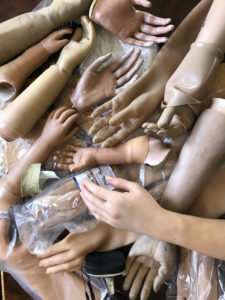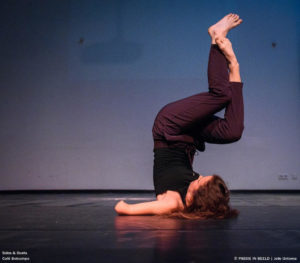Imagine being seen and recognized one way during your adolescence by people in your hometown. You move away, then return with a new take on life, both for yourself and the world. This scenario isn’t difficult to imagine as many Bay Area artists have experienced this time and again. Many have moved here because of the openness, acceptance, and capacity for building our true selves. When we return home with a different haircut, altered fashion, out sexuality, or in Julie Crothers’ case, without a “clunky appendage” (her description) people notice.
Crothers is a Bay Area dance performance artist and one of two Studio 210 Summer Residents for 2018 under the mentorship of Deborah Slater. She has one full-length right arm; the left stops at the elbow. Crothers has a box full of prosthetics that archive her childhood and adolescence; they represent how people in her hometown saw her in one way.
Crothers (26) plans to unpack her box in a new inquiry entitled Secondhand Store in a double bill with artist Kuan-Hsuan Lee. In Crothers’ proposal for the residency, she wrote:
Having spent the first 21 years of my life wearing a prosthetic arm, I have a fascinating collection: baby arms, robo-arms, swimming arms, old sockets and broken off fingers – all sitting untouched in a box in my closet. I’m interested in developing Secondhand Store to explore my relationship to prosthetics and their assumed and abstract uses.
Think about scratching your head with your right hand, then doing the same motion with your left. Notice the micro-movements in your shoulder, elbow, and forearm that are needed to achieve this. Now imagine Crothers doing the exact same motion with her left arm. Does your mind fill in the gap? Can you see the hair tousle even though no hand is actually touching it?
I’m curious about how the brain views a body in motion when it has to fill in the holes versus when the holes are filled by something artificial. I’m curious about gestures that hold space for an invisible arm compared to those that don’t. Specifically, I’m curious about what would happen if the left sleeve in my long sleeve shirt grew to 3 feet, 6 feet, 12 feet, so long that eventually all of me is all tangled up in excess, excess of something that was never necessary in the first place.

Crothers’ notion of putting on something that was never necessary calls to question why and how necessity is derived. What made Crothers believe she ever needed a prosthetic? Where does this necessity come from – Crothers’ own internal need or external factors such as social constructs, medical science, or others’ lived experiences?
Yeah, interesting – prosthetic arms were totally necessary in how I developed socially and in how I considered myself ‘just the same as everyone else’, but they were never necessary medically; I would have found a way to do anything and everything I needed to, with or without arm.
There also exists a notion of ‘normalcy’ that must be defined. To Crothers, ‘normal’ meant looking like other four-limbed humans; it meant being able to type on a computer with two hands; it meant being able to ride a bike. Common. Similar. Lack of difference. Fitting in.
To say, “Mom, Dad, I’m not wearing a prosthetic anymore,” carried the same weight and tone to Crothers as many of us have felt when coming out with our own non-conformity, our own rejection of ‘normal’. It affirms that we are ok being different, individual. What prompts this sloughing off of fitting in?
Critical theorist, Judith Butler (UC Berkeley), writes in Senses of the Subject, “…the interior sense of myself is sufficient to reaffirm my freedom, but this same sense of myself is insufficient to know it.”
Identity is a trending topic in our contemporary performance culture. Theorists like Butler have become icons for gender and sexual liberties – expanding the idea of fluidity into mainstream consciousness. Externally, we may fit one predetermined category – male, female, able, disabled – but, internally, we feel a different way, we fluctuate. Just as Butler in Senses posits that the very use of language acts on a body and our ways of identifying it, so too do external objects.
As Butler engages with the text of philosopher Maurice Merleau-Ponty, she argues that our external environment impresses upon us a change in state. Regardless of whether we are active in changing our Self, there exists a passive seeping in of experiences that shape and form our very identity through the objects present . For Crothers, this refers to her 21 years with attached appendages and the entirety of experience she had with each one. For dance, this refers to the experiences in performance settings – audience witnessing, performers moving, both being altered and changed whether knowingly or unknowingly. It is because of this change in state that prompts us to slough off previously defining traits and announce our individuality.
Jane Bennett, political theorist at Johns Hopkins University writes in Vibrant Matter: A Political Ecology of Things, “our gaze, prompted by the experience of our own body, will discover in all other ‘objects’ the miracle of expression.” Perhaps, Crothers, too will be asking the question that Descartes so famously asks and that Butler so scrupulously analyzes, “How could I deny that these hands and this body here belong to me?”
While it is very true that internal impulses give light to our Self, we are affected by the world around us, given outlets to freely express our ever-changing Self, shown options to “try on” – whether that be a physical object like Crothers’ new function-only-screw-aesthetic prosthetic, or a different feeling towards gender and sexuality. With this personal growth, we can begin to look more objectively towards that which defined (or may still define) us.
Crothers sheds light on how she’s working to transcend the definition of ‘normal’ by writing in her proposal:
These arms hold a lot of memories. But what [truth] can be found, rediscovered, or magnified by circling back and considering them not as something I rely on for my security, identity, or normalcy, but rather something absurd and still deeply personal?

As we age and grow into our Self, we still require a reference to the external in order to know our Self. But it is how we look at these externalities’ effect on us that really help to clarify who we are.
Have these prosthetics defined Crothers, created her, formed her own vision of herself, her identity? When I asked she replied,
More than I consider my identity as being formed by prosthetics, I consider my identity as having largely been influenced by the fact that I have 1.5 arms. Like the arms didn’t make me who I am, but rather my lack of arm did.
Crothers has now shifted the way she sees her prosthetics to a more objective stance, reducing her own personal attachment.
I do sometimes still wear [a prosthetic] – for yoga, exercise, riding my bike sometimes, or just for fun – but where the big difference is is in how my relationship to them has changed. … I do enjoy having the option of choosing to wear one if I want and appreciate being at a point in my life where I can look at them with a more abstract lens.
There is no doubt that Crothers must work to peel back layer upon layer of accumulated associations to her prosthetics. One cannot undo that lived experience quickly. But what Crothers can do is face these objects head-on through research in the studio, and present her findings (or continue researching) in front of others – inviting them to witness and discuss.
Much as every form of identity has a spectrum, we could potentially define Crothers’ relation to her prosthetics as at one end: reliance to feel a sense of normalcy; at the other: refusal of a perceived necessity. Before Crothers’ residency research began, she found herself living on multiple points in this spectrum. She wrote:
There’s something to be said about how in recent years I have been tempted to view the use of prosthetics in my current life [at 26 years old] as a weakness…like I don’t need it so I shouldn’t use it. But really, they are pretty darn cool and can have a lot of benefits, even if some of them make great Halloween costumes, fart noises, or play tricks on people.
Whether, in her culminating performance, Crothers decides to strew the prosthetics around the space and never recognize them or, alternatively, show off all their intricate gadgetries, it’s up to her to allow the process to inform the work. But what we can expect is a rich breadth of research and a sharing of humanness in the face of difference.
Now I have a lot of exciting material and creative fuel to work with as I process and reframe the usefulness of spare arms in my story.
This article appeared in the July/August 2018 edition of In Dance.


